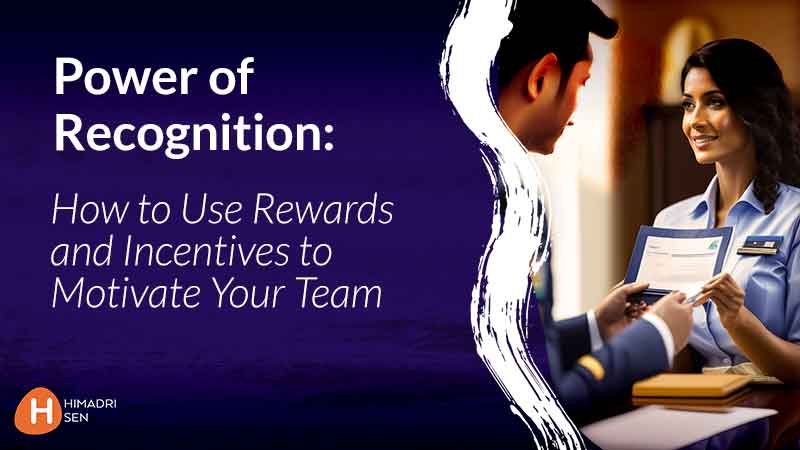Do you know that rewards and incentives can be powerful motivators for your team? Understanding how to effectively use incentives and rewards can have a significant impact on employee engagement and productivity.

In this article, we will explore the power of recognition and how to use rewards to motivate your team.
Key Takeaways:
- Understand the importance of recognition in the workplace.
- Identify the different types of recognition and rewards.
- Design a reward and recognition program that fits your team’s needs.
- Set clear and achievable goals for your team to work towards.
- Communicate the rewards and incentives program clearly to your team.
- Be consistent in your reward and recognition program.
- Monitor the effectiveness of the program and make adjustments as needed.
This article focuses on the power of recognition and how to use rewards and incentives to motivate your team.
By understanding the importance of recognition, identifying different types of rewards, and designing a program that fits your team’s needs, you can increase employee engagement and productivity.
How to Use Rewards and Incentives to Motivate Your Team
We will discuss setting clear goals, communication, consistency, and monitoring the program’s effectiveness.
Why Recognition Matters
- The impact of recognition on employee motivation
- The psychological factors behind the power of recognition
- Types of recognition: verbal, written, and tangible rewards
- The importance of personalized recognition
Choosing the Right Rewards
- Identifying what motivates your team
- Finding the balance between intrinsic and extrinsic rewards
- The value of non-monetary rewards
- Creating a reward system that is fair and consistent
Implementing a Recognition Program
- Setting clear goals and criteria for recognition
- Getting buy-in from leadership and team members
- Communicating the program effectively
- Creating a process for selecting and delivering rewards
Overcoming Common Challenges
- Avoiding favoritism or bias in recognition
- Addressing potential jealousy or resentment among team members
- Adapting the program to fit remote or virtual teams
- Dealing with limited budget or resources for rewards
Measuring the Success of Your Program
- Setting benchmarks for success and tracking progress
- Gathering feedback from team members on the program
- Analyzing the impact of recognition on employee engagement and retention
- Making adjustments and improvements based on data and feedback
Examples of Successful Recognition Programs
- Case studies of companies with effective recognition programs
- Highlighting unique and creative ways to recognize employees
- Learning from successful programs in different industries and contexts
- Understanding how to adapt and customize recognition programs for your own team
Making Recognition a Habit
- Cultivating a culture of appreciation and recognition
- Encouraging peer-to-peer recognition
- Incorporating recognition into performance evaluations and goal-setting
- Maintaining the momentum of your recognition program over time.
PROS
- Increases job satisfaction and employee retention.
- Boosts productivity and performance levels.
- Encourages healthy competition and teamwork.
- Creates a positive work environment and culture.
CONS
- Can create a sense of entitlement among employees.
- May lead to unhealthy competition and resentment.
- Can be expensive and not sustainable long-term.
- May not always align with the company’s values and goals.
FAQs:
What types of rewards and incentives are most effective?
Rewards and incentives that are meaningful and personalized to each employee tend to be the most effective.
How often should rewards and incentives be given out?
It depends on the company and its culture, but typically they should be given out on a regular basis, such as monthly or quarterly.
Should rewards and incentives be monetary or non-monetary?
Both types of rewards can be effective, but non-monetary incentives such as recognition and extra time off can also be highly motivating.
How do you avoid creating unhealthy competition among employees?
By focusing on teamwork and collaboration, setting clear goals and expectations, and rewarding behaviors that contribute to the overall success of the team.
Can rewards and incentives backfire and demotivate employees?
Yes, if they are perceived as unfair or if the criteria for earning them are unclear or constantly changing.
How do you measure the effectiveness of rewards and incentives?
By tracking employee engagement, retention rates, and overall performance levels.
Wrapping up:
The power of recognition through rewards and incentives can be a highly effective way to motivate and inspire your team. By understanding what drives your employees and implementing personalized, meaningful incentives, you can create a positive work culture and drive success for your company.
However, it’s important to be mindful of potential drawbacks and continually evaluate the effectiveness of your reward and incentive programs.
With the right approach, you can harness the power of recognition to build a strong, motivated, and high-performing team.




